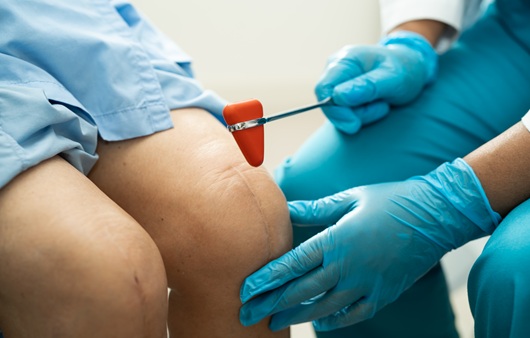Once the knee is damaged, it does not regenerate naturally. Sometimes, people may have the complacent thought, ‘If I have a problem with my knee, wouldn’t it be okay to have surgery?’ However, there are limits to the ability to treat knees with various treatments, including surgery. Even if an artificial joint is inserted, the pain can be relieved, but the knee movement cannot be performed accurately.
Knees break down more easily as you get older. It’s not easy to think, ‘I just need surgery.’ | Source: Getty Image Bank
‘Surgery’ is the final destination for knee disease… Must choose carefully
For knee diseases, drug treatment, physical therapy, and exercise therapy are usually given priority. In the early stages of the disease, sufficient improvement in symptoms can be expected with these conservative methods. Injection treatment is also performed. Well-known injection drugs are steroid injections and hyaluronic acid cartilage injections. Steroid injections are effective in relieving acute pain and inflammation, and cartilage injections have an anti-inflammatory effect and protect the joints.
If symptoms are not alleviated even after these treatments have been performed for more than 3 months, surgical treatment should be considered. However, surgical treatment must be carefully considered. Because once you do it, it’s hard to go back. In addition, recent technological developments have made it possible for artificial joints to reproduce much of the function of normal joints, but human joints are still the best.
Therefore, surgery should be chosen as a last resort when pain is severe and other treatments are no longer effective. However, if the surgery is delayed, the results of the surgery may not be good and walking may become difficult, so it is wise to discuss with an expert whether to have surgery and the appropriate timing of the surgery.
[무릎 수술을 고려해야 하는 경우]
▲ If the knee is deformed
▲ If pain persists no matter how much you rest
▲ Difficulty performing daily activities such as walking
▲ When other conservative treatments fail
Knee surgery includes ‘arthroscopy’, which inserts an arthroscope to widen the joint gap and observe the knee structure in detail, and ‘proximal tibial osteotomy’, which realigns the bone to reduce pressure on the damaged area. Arthritis that has damaged cartilage or is of moderate severity can be easily treated with these surgical methods.
If the degree of damage is severe, you should consider ‘artificial joint replacement‘, which replaces the worn-out cartilage with an artificial implant. This is a surgical method that removes problematic bones and ligaments and replaces them with special metal and plastic. The results of artificial joint replacement surgery are mostly good, but in rare cases, side effects such as infection, blood clots, and instability of the implant may occur, so it must be chosen carefully. The Korean Orthopedic Society says that replacement artificial joints may eventually wear out and require revision surgery, so it should be chosen as a last resort. Revision arthroplasty is known to be more difficult and produce worse results than initial joint replacement surgery.
It’s not the end after surgery. After surgery, thorough care must be taken to prevent the disease from recurring. In particular, after artificial joint replacement surgery, patients must visit the hospital periodically to check for any abnormalities in the artificial joint. Lifestyle habits also require attention. Because artificial joints cannot be used permanently, it is best to avoid strenuous exercise or excessive knee bending.


